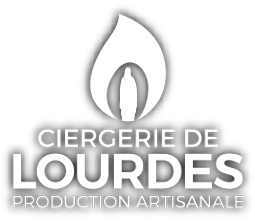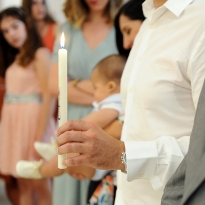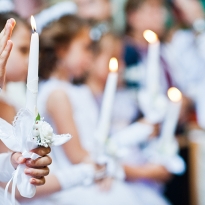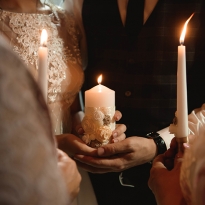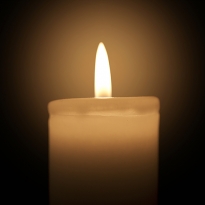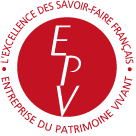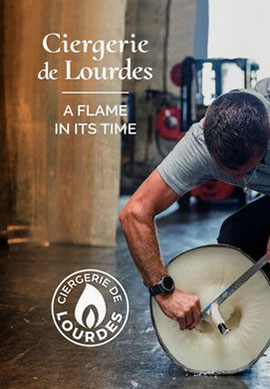THE ALTAR CANDLE SYMBOLISES LIGHT
AN ALTAR CANDLE IS AN ALTAR CANDLE,
BUT THE LOURDES ALTAR CANDLE HAS A HISTORY.
THE VIRGIN MARY, THE GROTTO AND THE ALTAR CANDLE ARE ONE AND THE SAME.
THEY ARE ONE OF A KIND.
An altar candle is a candle whose use is exclusively reserved for worship. In the liturgy, every time the Christina community reunite to celebrate we light an altar candle.
THE ALTAR CANDLE SYMBOLISES LIGHT
The altar candle serves the light and as the words of Christ highlight:
“I am the light of the world. Whoever follows me will never walk in darkness, but will have the light of life”.
The altar candle may be more or less wide, long or slender depending on its purpose. We mainly distinguish:
 The Paschal Candle that represents Christ resurrected
The Paschal Candle that represents Christ resurrected
 The Liturgical Candle: altar candles
The Liturgical Candle: altar candles
 The Devotional Candle: the altar candle that you hold.
The Devotional Candle: the altar candle that you hold.
 The Baptism Candle
The Baptism Candle
 The Candlemas Candle
The Candlemas Candle
 The Altar Candle of Marian Processions
The Altar Candle of Marian Processions
-
The history of the Altar Candle & Bernadette
Light has always been present and accompanied man since the dawn of time. Because of persecutions, the first Christians were forced to gather in hidden, underground places where they needed light. Also, the very first churches let very little light through to inspire contemplation in the darkness.
For centuries, rush was used to make tallow candles. Carefully melted so as not to damage the pith, it was soaked in animal or vegetal fat left to harden. It was burnt in a rush-burner.
In the West, from the Middle Ages, the tallow candle competed with the oil lamp.
Made of a wick surrounded by beef or sheep tallow, the tallow candle was more practical without being excessively expensive (but it was taxed, and oil remained more economical).
The term “bougie” (candle in French) only appeared in the French language in the 14th century. It is taken from the word BUGAYA, the transcription into Arabic of the Kabyle word BGAYET, name of a maritime town in Algeria (currently Bejaia).
This town supplied a large quantity of wax used in tallow candles instead of tallow. At the time, candles were naturally yellowish in colour. You could obtain white ones if you left the wax to whiten in the sun beforehand for several days if not weeks. White candles were more expensive and were only used in royal palaces at the time.To sum up, the word “bougie” is only used for products made of beeswax and the word tallow candle is reserved for products made from tallow.
The nobility and the clergy produced light with beeswax candles, while the French people used tallow candles with sheep or cow tallow which were a lot cheaper.
The candle, as we know it, was developed in the middle of the 19th century and can be distinguished from the tallow candle by its raw material and by the use of braided cotton wicks.
The tallow candle started to disappear.
Thanks to the discoveries of certain chemists, the stearic candle was invented (made from a particular fatty acid: stearic acid).
The appearance of solid paraffin and stearin (extract of vegetable or animal fat) now allowed better quality candles to be produced.
The 19th century would revolutionise the candle but also our town of Lourdes through the apparitions of the Virgin Mary before Bernadette Soubirous. -
The Lourdes altar candle is made in Lourdes
Throughout the tale of apparitions, we observe how strongly the altar candle in Lourdes features.
It has always been present and for each pilgrim, sick person or visitor symbolises a guiding light amidst his or her anxiety or distress, in any case a light towards relief and hope.THE LOURDES ALTAR CANDLE CONVEYS A PERSONAL MESSAGE.
Bernadette was a commoner; she was poor and only had tallow candles. They weren’t white but creamy white.
Today the altar candles made at Ciergerie de Lourdes are not pure white either but a creamy white. They are covered at the base with Marian blue (reminder of Virgin Mary’s blue belt). We make them here, in the Marian city.
AN ALTAR CANDLE IS AN ALTAR CANDLE,
BUT THE LOURDES ALTAR CANDLE HAS A HISTORY.
THE VIRGIN MARY, THE GROTTO AND THE ALTAR CANDLE ARE ONE AND THE SAME.
THEY ARE ONE OF A KIND. -
The altar candle and Lourdes: a sacred union
You have to dive back into the period of Bernadette where fire and the altar candle featured strongly in the life of the Bigordans.
At the time, medicine had not acquired the scientific dimension that we know today and more often than not we called on the diagnosis of altar candles when healers had reached the limits of their knowledge when faced with illness. We had a candle at the four feet of the bed to which the name of four saints conducive to healing was given. The first finished candle indicated the Saint whom you had to worship.
In the summer solstice like everywhere, the people of Lourdes made huge fires to celebrate Saint John the Baptist. They offered prayers then men, women and cattle jumped through the flames to request his benevolence. Fire was still an ally against a lot of uncertainties and the unknown at this time. In those days, the clergy favoured two natural elements that it blessed on different occasions: water and altar candles. The altar candle belongs to the realm of the sacred.Now that have set the scene we can better understand Bernadette’s attitude before the Lady and the role of the altar candle throughout the apparitions.
-
The altar candle and apparitions
With the first apparition, Bernadette was fearful and anxious faced with this event that she didn’t understand. She would have to deal with it with the weapons she had.
Holy water and the blessed altar candle
During each apparition from the third one, an altar candle was present and lit. Bernadette asked Mrs Milhet to bring her altar candle blessed by the candle maker to protect them. Bernadette related that Our Lady continuously looked at the light. For the following apparitions, Bernadette was accompanied by her Baptism candle lit by her aunt Lucie, also her godmother. She lit it until the seventeenth apparition.
Light was omnipresent in the apparitions: light on the face of Bernadette, the invisible light of Our Lady and the light of the altar candle.
During her raptures, Bernadette was cut off from the world, isolated. When the flame of her altar candle went out because of a draught, she held it out to her neighbour who immediately relit it. As if the altar candle was involved in the rapture. As if it involved a three-way encounter: Our Lady, Bernadette and the lit altar candle.
The seventeenth apparition was called the “Miracle of the Altar Candle”
It was the Wednesday after Easter, the 7th of April 1858. The Paschal candle was burning in the parish church when a miracle occurred in the grotto in front of everyone.
And to understand the sequence of events of this apparition, we must go back to the 6th of April 1858.
In Lourdes there was an extraordinary flurry of activity around the house of the Soubirous family, in the Rue des petits fossés. Everybody wanted to touch and meet Bernadette.
On the morning of the 6th of April, the son Vergès had invited them to eat because his father Blazy wanted to thank Bernadette for his recovery. The Soubirous family accepted the invitation to escape the tumult in Lourdes for a few hours.
They went to Adé where Blazy, former village mayor, was a wine merchant. He had suffered from crippling rheumatism for years and his doctor, Doctor Larré, was unable to relieve him. Having heard about a new spring in Massabielle that soothed aches and pains, he led his patient there who soaked his shoulder in it. But nothing, no effect before returning to Adé where, back home he rediscovered the use of his shoulder.
With this invitation he wanted to thank Bernadette for having found the spring as well as Our Lady and give thanks to her for his newfound health by offering her a large altar candle.
Bernadette asked to be taken to Lourdes to Father Pomian to confess and have the Blazy altar candle that she wanted to take to the grotto the next day blessed.
In the evening, the son Vergès called at the Soubirous house again. The atmosphere was unbearable. He suggested that they come and sleep in Adé. He promised to take them to Lourdes, to the grotto in the early hours of the morning. They accepted.
On the morning of the 7th of April, he left the Soubirous family at the grotto where numerous people were gathered waiting for Bernadette. Doctor Dozous witnessed the apparition to attest the truth of events.
Bernadette was on her knees before the grotto and placed the altar candle in front of it. Going into raptures, she put her hands on the flame to protect it and did so for ten minutes. Witnesses present said they saw the flame in the middle of her fingers. But she didn’t feel the heat. The apparition lasted more or less an hour. At the end, Bernadette got up and wedged the large altar candle at the back of the grotto where it finished burning. Doctor Dozous stopped her to examine her hands on which he saw no traces of burning. Several people familiar to Bernadette and present during this apparition had her redo the same thing again that evening above a tallow candle. Bernadette was surprised by their attitude because she didn’t remember her hands in the middle of the flame. She couldn’t keep her hands in the flame as she burnt herself.
With the previous apparition Our Lady asked her to leave her altar candle burning in the grotto. The people of Lourdes and visitors imitating Bernadette left their altar candles burning in the grotto in turn. Faced with the scale of the altar candles left behind, Commissioner Jacomet forbade anyone from leaving candles in that place.
The account that follows reveals the message of Lourdes.
A lady with a sick child called out to Bernadette. She asked her to pray for her child and gave her an altar candle to present it to the Virgin Mary.
Bernadette replied that she would pray for her child. As for the altar candle, she invited her to burn it herself at the grotto or at the church in honour of the Virgin Mary.
This message is intended for each of us. We must each make a personal process of prayer accompanied by a lit altar candle as a sign of light.
This is how the light that symbolises Christ continuously shines in the Marian city through the altar candle.ONE OF THESE EVENTS IS THE “TORCHLIGHT PROCESSION”
The Torchlight Procession dates back to the time of the apparitions, during the “month of Mary”.
On the 7th of May 1858, Commissioner Jacomet had a sign erected at the grotto: leaving anything here is forbidden, subject to a fine.
The people of Lourdes would work on bypassing this prohibition. The first to find a loophole were the young girls of the sorority of the Children of Mary. They decided to go on a procession to the grotto at nightfall singing the praises of the Virgin Mary with lit altar candles and to leave with them. Their procession was a real success. The commissioner got angry and considered pursuing them for causing a disturbance at night. The vicar of the parish Father Peyramale had to have words so that the possession could take place but with less ardour.The Marian procession was born.
A few years later a Capuchin father from Toulouse, Father Marie-Antoine de Lavaur, took over the torchlight procession during the first pilgrimages in 1872.

